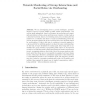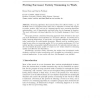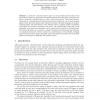1074 search results - page 193 / 215 » Rule sets based bilevel decision model |
106
click to vote
CIA
2004
Springer
15 years 5 months ago
2004
Springer
We are investigating how to provide intelligent, pervasive support of group of people within so-called “smart environments”. Our current main assumption, based on literature in...
GFKL
2006
Springer
15 years 3 months ago
2006
Springer
Stemming algorithms find canonical forms for inflected words, e. g. for declined nouns or conjugated verbs. Since such a unification of words with respect to gender, number, time, ...
79
Voted
LREC
2008
15 years 1 months ago
2008
Many NLP modules and applications require the availability of a module for wide-coverage inflectional analysis. One way to obtain such analyses is to use an morphological analyser...
101
click to vote
CORR
2007
Springer
14 years 11 months ago
2007
Springer
Discrete temporal transitions occur in a variety of domains, but this work is mainly motivated by applications in molecular biology: explaining and analyzing observed transcriptome...
CJ
2010
14 years 9 months ago
2010
A policy for a minimal reactive agent is a set of condition-action rules used to determine its response to perceived environmental stimuli. When the policy pre-disposes the agent t...



